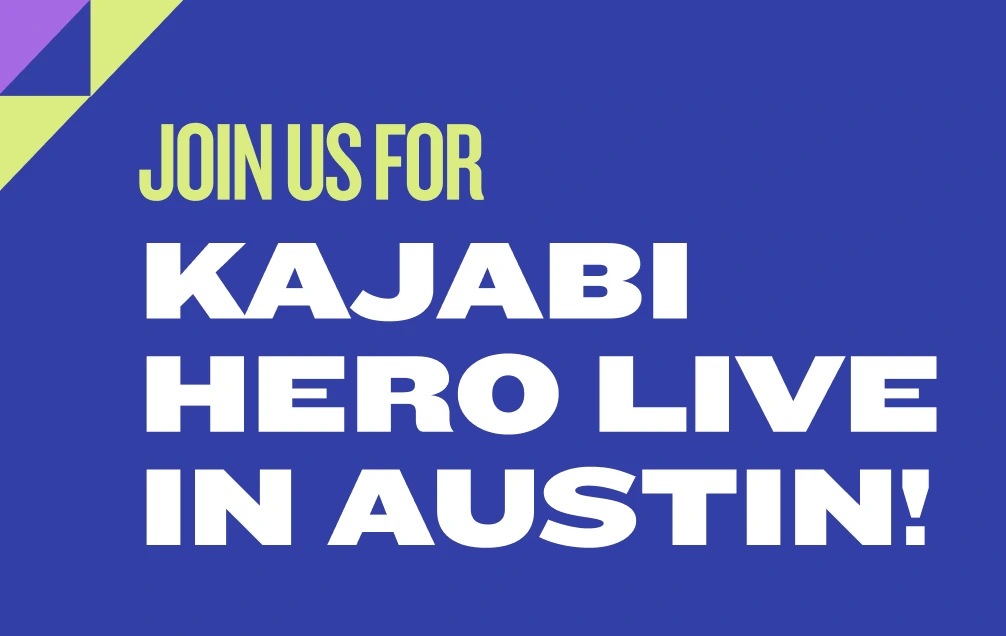
What is copywriting & 5 tips for writing content that converts
Get free expert insights and tips to grow your knowledge business sent right to your inbox.
Think of copywriting as the key to success in content marketing. It’s the practice that allows you to attract potential customers to your online courses.
If you’re thinking about starting an online business that sells digital products (or if you’ve already done so), you need to master copywriting. But what is copywriting and how can you use it to convert prospects into customers?
We’re going to take an in-depth look at copywriting so you can use these tactics to bring in more leads to convert. Once you understand how copywriting works and its best practices, you’ll have a better chance of earning your own Kajabi Hero T-shirt.
Plus, you might find that your online courses become more powerful, impactful, and genuine once you’re an expert at copywriting. Every piece of content you create will have better focus and more value.
What Is Copywriting?

Copywriting is the art of creating content designed to convince readers to take a specific action, such as to buy your online course, subscribe to your email list, join a free webinar, or any other next step you want them to take.
For instance, if you’re designing a Kajabi sales page for your online course, you’ll use your copywriting skills to make your offer as attractive as possible to potential customers.
One of our Kajabi Heroes, Andrew Bryant, creates online courses and other digital products about personal development. If you visit his website, you’ll find sales pages for his online courses.
His sales page for his self-leadership book looks like this:

You’ll notice that he uses a gripping headline, a video to introduce his brand, and clear pricing options. His copywriting skills are evident in the words he chooses (and the ones he’s decided to emphasize.
You can create a similar sales page for your Kajabi online courses.
Of course, other pages on your Kajabi website can also benefit from good copywriting skills.
Landing pages, for instance, are designed to funnel traffic toward a specific call to action. You need crisp, clear sentences that emphasize the benefits of a specific product purchase or other conversion.
Nic from MPower Academy uses her copywriting skills to convince prospects to download her free Kickstarter e-book. To get this lead magnet, you have to click on the “sign up” button and provide your email address.

Why does this matter? Nic is collecting her prospects’ email addresses so she can communicate with them through that medium. Email marketing is another strategy that demands excellent copywriting skills.
Using a lead magnet can vastly increase your subscriber base. However, you need good copy if you want your leads to provide their contact information.
From these examples, it’s clear that copywriting has lots of moving parts. At its most basic, however, it’s the art of using words to convince people to do what you want. And it’s used in every industry — both in print and digital copy.
Why Does Copywriting Matter for Your Online Courses?

Imagine that you’re looking for an online course to take. You’re interested in online learning, so you type a query into the Google search bar.
The results that come up on the page take you to potential courses that might meet your needs. You’re likely to go with a course that you find on the first page of the search results rather than click through to the second page.
Without good copy, you won’t appear in those search results. In other words, potential customers might want the online course that you’ve created, but if they can’t find you, how can you possibly generate sales?
That’s why copywriting matters for your online courses.
You want people to find you through organic search results. You can also run paid ads, promote your courses on social media, and start an email marketing campaign.
All of those strategies require good copywriting skills.
It’s not just about getting found via Google search. You also want people to feel enticed by the offer you present.
Have you ever been turned off by a business because their sales copy didn’t answer your questions or provide you with any incentive to buy? That’s bad copywriting.
You want the opposite.
Free Training: Learn How To Launch & Grow Your Knowledge Commerce Business
Register here to watch our free training today!
Are Content Marketing And Copywriting the Same Thing?

Copywriting is a form of content marketing, but the two concepts are different.
Think of content marketing as an umbrella term that covers any content you create and distribute on behalf of your brand. It’s blog posts, social media posts, emails, print copy, press releases...the list goes on.
Many forms of content marketing have nothing to do with sales directly. You might write a blog post, for instance, that’s designed to educate your audience. Other than a call to action at the end of the post, the content is about education rather than sales.
Copywriting, on the other hand, refers strictly to content marketing that leads to conversions. It’s copy that you use to convince people to buy.
The call to action we mentioned above? That’s copywriting. While most of the blog post would be considered content marketing, the CTA is an example of copywriting.
10 Benefits Of Copywriting
If you’re not yet convinced that you need copywriting skills to sell online courses, we’re going to go through 10 benefits you can enjoy if you’re committed to learning how to write excellent copy.
1. Attract More Organic Search Traffic

Search engine optimization (SEO) refers to the practice of optimizing content for organic search traffic. The better your SEO, the greater the chances that your content will appear on the first page of the SERPs for chosen keywords.
For instance, if I search for the keyword “metabolism-boosting e-course,” the first result comes from one of Kajabi Hero Randi Dukoff’s sales pages:

She’s landed in the coveted number-one position in the SERPs because she’s optimized her sales copy for search.
You can master SEO by understanding the fundamental principles:
- Include your focus keyword at least two or three times on the page.
- Use LSI (related) keywords throughout the copy.
- Employ a semantically correct heading hierarchy.
- Write long-form content that delivers plenty of value.
- Attract backlinks from high-authority sites.
- Include internal links in the content.
- Add images and videos to your copy.
- Fill out meta information.
These are just the basics. The more you learn about SEO, the more you can optimize your content.
2. Speed Up Your Content Creation
When you’re familiar with copywriting best practices, you can produce copy faster and more efficiently. The right words will simply come to you because you’ve built up experience.
This doesn’t mean that you should get lax about your copywriting efforts. Spend time crafting headlines, sentences, paragraphs, and sections so they communicate value and persuade your audience.
However, efficiency and speed come with several benefits. For one thing, you can spread your message further because you’re more productive. Secondly, you can expect to get more done during the day, which frees up your time to focus on creating online courses.
3. Distribute Your Content Widely
Content distribution matters more today than it ever has before. You’re competing for your audience’s attention against billions of other pieces of content. Without copywriting skills, you can’t rise above the din.
Great content gets shared on social media, emailed to friends and colleagues, reposted on Tumblr, and otherwise shared with networks to which you don’t have direct access. In other words, good copywriting skills can help get your content in front of other people’s audiences.
That’s a powerful reason to brush up on your copywriting skills. Poorly written content doesn’t get distributed or shared, which means that your brand fades quietly into the background.
4. Generate More Ideas for Content

When you’re familiar with copywriting best practices, you’ll find that content ideas come easier to you. For instance, maybe you’ve reviewed Copyblogger’s extensive resources for creating magnetic headlines. Your headlines will come naturally to you because you know what works.
Remember when we told you that billions of other pieces of content are vying for your audience’s attention? This means that you need to produce more content so people can find you more easily.
Blogs, for instance, drastically increase the number of pages on your site. If you optimize each blog post for a specific keyword, you create a new way for potential customers to come into contact with your brand.
5. Improve Social Media Engagement

Copywriting often boils down to the best, most concise way to convey a piece of information. In addition to the mounds of competition that stand between you and your target audience, you’re also faced with consumers whose attention spans have drastically shortened.
Social media offers the perfect platform to distribute bite-sized pieces of content. Sites like Twitter force you to communicate more concisely, and if you’re familiar with word economy, you can get your message across in fewer words.
That’s a big part of content marketing and copywriting. While we recognize the value of long-form content (such as this blog post), we also know that we need to distribute short-form content so we can reach every potential customer.
Good social media copy gets shared, liked, and otherwise engaged with by your audience. You’ll fuel interest in your brand and increase brand recognition, which can easily translate into more sales.
6. Convert More Leads
If copywriting has a single goal, it’s conversions. You want to convert leads into prospects and prospects into customers.
A lead is someone who has just come in contact with your brand. He or she doesn’t know you or your digital products, so you have to provide education, entertainment, and inspiration.
Good copywriting facilitates those goals.
A lead turns into a prospect by converting on an offer that you provide. For instance, we talked about lead magnets earlier. You might offer expandable content, a free e-book, or some other piece of content in exchange for a lead’s email address.
When that conversion happens, you’ve converted your lead into a prospect. That person is now more familiar with your brand — and more likely to make a future purchase.
But your job’s not done yet. You still have to convert the prospect into a customer.
How? By writing engaging copy. From email marketing to social media posting, you must engage with your prospects and convince them that your online course offers the best solution to their problems.
7. Build Your Brand Image
Even if you’re not aware of it, your business has a brand. Your brand consists of your reputation and your unique attributes.
It’s far more effective to build your brand image purposefully than to let it organically develop. Every piece of content you post or share should reflect your brand image and make you more recognizable.
Many factors can influence your brand image:
- Voice and tone in content marketing
- Imagery on your website and in your emails
- Logo design and colors
- Font choices
- Customer experience
- Customer service
If you decide how you want to handle each of these factors, you’ll develop an intentional brand image. And — you guessed it — this all starts with copywriting.
When you’re engaged in copywriting, you’re speaking directly to the consumer. If you’re persuasive, you’ll convert consumers into customers.
8. Establish a Relationship With Your Customers

Relationship marketing has become one of the most powerful ways to connect with your prospects as well as your existing customers. You want consumers to feel like they have a relationship with you — and, by extension, with your brand.
How does this happen? Through effective copywriting. From personalizing your email messages to responding to comments on social media, every interaction creates an impression.
You want it to be a good one.
Additionally, using your natural voice and talking directly to the consumer can enhance the sense of intimacy people feel when they connect with your brand. You’ll gradually develop brand loyalty and even brand ambassadorship if you master copywriting.
9. Build Authority and Credibility
Poorly written content sends a crystal-clear message to your prospects: “I don’t really care about what I’m doing.”
That’s not what you want to say.
You might be the foremost expert in your industry, but if you can’t write engaging content, you’ll never sell your online courses.
Do you have to become Ernest Hemingway? Of course not. However, you need to master your language and use it wisely.
When people see that you’re a competent writer, they’ll put more stock in your authority and credibility. They’ll come to see you as a trusted expert in your industry, which makes them far more likely to buy your online courses.
10. Learn How to Convince Consumers to Buy
Persuasion. It’s the cornerstone of copywriting.
You’re exposed to copywriting every day, whether you’re reading a blog post or viewing an advertisement in a magazine. The end goal is to convince you to take the desired next step.
It could be buying a washing machine and dryer set or hiring a company to mow your lawn.
In your case, it’s buying your online courses. You need persuasive copy if you want to convert consumers into customers.
Learn how to use powerful verbs, engaging adjectives, and varied sentence structure to keep your prospect engaged. The more persuasive you are, the more sales you’ll make.
10 Tips for Creating Content That Converts

Surely, we’ve convinced you that copywriting isn’t something you should ignore. In fact, it’s an essential skill for today’s entrepreneurs.
But how do you become a good copywriter? That’s an excellent question, and we’ll cover 10 tips to help you master copywriting and persuade more people to buy your courses.
1. Understand Your Audience’s Objections and Pain Points
It might sound like copywriting is all about your business, but it’s really about your customers. What do they want? How can you give it to them?
When you know your prospects’ pain points and objections, you can write specifically to those issues. Give your readers something juicy to latch onto so they feel compelled to buy.
Objections are issues in your prospects’ minds that tell them they don’t want or need your course. Common objections include price, time, and desire. If a customer thinks your course is too expensive, takes too much time, or won’t provide sufficient value, he or she won’t buy.
You can answer those objections in your copywriting by using logic. Provide concrete evidence that those objections have no basis in fact.
Pain points are issues that your customers face. They want to achieve a goal or solve a problem. Your online course serves as the solution to these problems.
For instance, if you create online courses about crafting, your audience’s pain points might include a lack of craftiness. They might feel that they don’t have the skill necessary to complete craft projects.
It’s your job, through copywriting, to convince them that you’ll help them overcome their pain points.
2. Focus on Benefits Instead of Features
Features refer to specific course materials and other specifications. Benefits tell your customers what they’ll gain from taking your online course.
That’s an important distinction. Features read as dry and boring, while benefits prove persuasive and captivating.
Check out these two pieces of copy:
- My course comes with 100 hours of video, email chat, an online community, and more than 30,000 words of content.
- With my online course, you’ll learn how to become a more effective salesperson using my proven methodologies. Discover how to close the sale, identify key decision-makers, and build your network.
Which one sounds more enticing? The second one. It’s specific and focuses on the benefits of this course.
3. Create an Emotional Bond With Your Prospect
Emotion matters just as much as — if not more than — logic in copywriting. You’re appealing to consumers’ desires rather than their brains.
Why do people buy things? They want to feel good. They want to solve problems. They want to reach their goals. All of those desires are based on emotions.
Good copywriters know how to tune into their prospects’ emotions through evocative prose. They paint pictures with words and help buyers picture themselves benefiting from a product.
4. Generate a Sense of Urgency
Have you ever watched QVC? The hosts talk about a specific product, often demonstrating out it works or providing product tours. At the same time, you see the words “limited quantity” on your screen.
You only have a certain amount of time to take advantage of the deal. After that, it’s gone — perhaps forever. At least at the low price point.
That’s the exact impression you want to generate with your copywriting. Impose a sense of urgency on your readers so they feel compelled to act now.
How do you generate a sense of urgency? Through your words. Use phrases like “act fast,” “before it’s gone,” “last chance,” and “don’t miss out” to suggest to your audience that they need to move if they want to take advantage of your offer.
5. Don’t Forget The CTA
Copywriting often hinges on the call to action (CTA) in the copy. A CTA can appear at the end of a blog post, in a social media post, in an email, or anywhere else you think it might belong.
It’s especially important on your sales pages. Once you’ve attracted a prospect to your sales page, you want him or her to buy your online course before clicking away.
When you’re well-versed in the art of persuasive copywriting, CTAs become far easier to write. You know how to tap into your prospects’ pain points and get them to buy. If you forget the CTA, however, you’re missing a huge opportunity to sell your course.
6. Vary Your Language
When your sentences and paragraphs are all the same length and you use the same words over and over, your reader gets bored. Don’t let that happen.
Vary your language in each piece of copy so it remains engaging throughout. Follow up a short, perfunctory sentence with a longer one. Grab your trusty thesaurus and find new ways to convey information.
7. Speak Your Audience’s Language
Speaking of language, do you know how your audience talks? If not, you’re missing out on a prime opportunity to connect with prospective customers.
Spend time with people who fall into your target market. Do they speak formally or informally? Do they use lots of emojis and text speak? What’s their vocabulary level?
You need to mirror these facts in your own writing. Your audience will feel an instant connection.
8. Ask for What You Want
You won’t know until you ask, right? That’s the accepted wisdom — and it’s true.
Too many marketers assume that customers will convert and buy just because they’re presented with information. This isn’t always the case.
Instead of trusting your audience to buy just because your online course exists, ask them to buy. You can do this in your CTA as well as throughout the rest of your content.
9. Convey Practical Information

If you’ve researched copywriting at all, you might have come across the phrase “fluffy content.” It refers to copy that contains lots of filler words and phrases that don’t mean anything.
Condense your copy as much as possible. You still need to inject personality into your words and phrases but don’t go out of your way to add more words to the page.
Focus on conveying practical information that your prospects can use to make an informed, educated decision.
10. Write Like You Talk
Some marketers and entrepreneurs think they need their copy to sound like a thesis report for a college class. Don’t do that. Write like you talk instead.
Use informal language whenever possible to create a sense of intimacy. Even if your audience consists of high-level executives, you can still use contractions and informal phrasing.
Sell Your Content Online Using Kajabi

We’ve covered the benefits of copywriting and the ways to make your copy sing, but what do you do with that information?
Start by creating a Kajabi account. With our platform, you can create and distribute your copy far and wide. Before you know it, you’ll have a profitable online business on your hands.
By creating online courses, you can generate revenue and lend your expertise to as many customers as possible. Engage your prospects with compelling copy so they can’t say “no” to your offer.
Conclusion
Have we convinced you yet? If you’re not good at copywriting now, you might want to start learning. There are tons of benefits that can impact your bottom line and build your brand image.
You’ll generate more sales, convert more leads, build authority, persuade your prospects, and generate more ideas for content. Good copywriters also tend to produce copy faster and distribute their content more widely.
It’s true that copywriting and content marketing have things in common, but copywriting is a specific subset of content marketing. It’s the type of copy that you use to persuade your prospects to convert.
With that in mind, you have to develop your persuasion skills and learn how to translate ideas into written text.
It’s not as hard as it looks.
Start by getting to know your audience better. Figure out their pain points, objections, and goals so you can address them in your copy. Make sure you’re highlighting the benefits of your online courses instead of a dry list of features.
Appeal to your prospects’ emotions and engender in them a sense of urgency. Make them feel like they have to take advantage of your offer right now to avoid missing out on an incredible deal. Then add a compelling CTA to your copy.
You’ll want to vary your language to keep your copy interesting and speak your audience’s language. Don’t condescend to them or use too much jargon. Figure out how they communicate and mirror it.
Don’t forget to ask for what you want. Consumers don’t just buy products out of the blue. They respond to an invitation, so make sure you give them one.
Finally, convey practical information that your readers can use and write just like you talk. Inject plenty of personality into your writing so your audience connects with you emotionally.
It’s not difficult to write great copy if you’re familiar with the best practices.
What do you struggle with when it comes to copywriting? Have you learn copywriting skills?
Free Training: Learn How To Launch & Grow Your Knowledge Commerce Business
If you're ready to put your copywriting skills to use, watch our free training where we'll teach you how to grow your Knowledge Commerce business, no matter what your niche is!
Watch Our Free Training Now
Launch & Grow Your Knowledge Commerce Business Today













